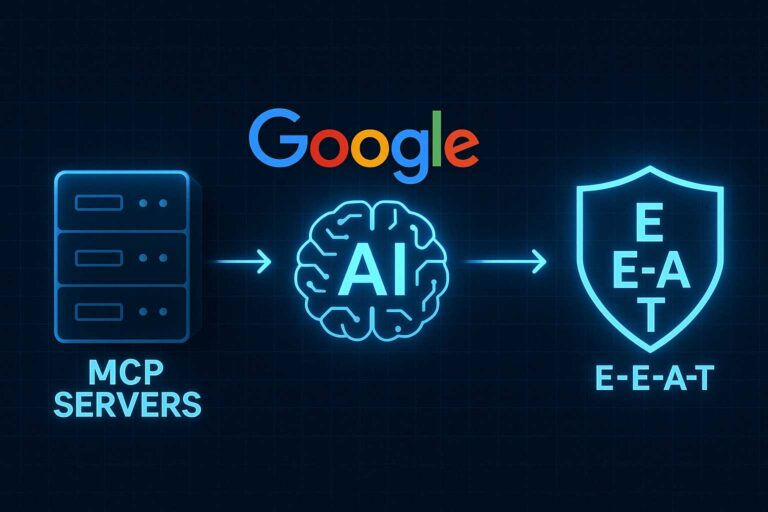How to Optimize Your Website for Google’s AI-Generated Search Results in 2025
What Are Google’s AI-Generated Search Results?
Google’s Search Generative Experience (SGE) is redefining how users interact with search results. Instead of relying solely on a list of blue links, Google now provides AI-powered summaries that deliver direct answers to user queries. This advanced system leverages natural language processing to understand complex questions and present conversational responses at the top of the search results.
Unlike traditional search results, these AI-generated summaries pull information from multiple sources to create a cohesive response, reducing the need for users to click on individual links. This shift prioritizes content that is not only highly relevant but also structured in a way that AI can easily parse and present.
For businesses, this means adapting SEO strategies to ensure their content is featured in these AI summaries. Traditional ranking factors like keywords and backlinks are still important, but Google’s AI now places greater emphasis on context, clarity, and authority. Optimizing for these factors ensures your content has a better chance of being included in AI-driven results, positioning your brand as a trusted source of information in its field.
Why AI Search Results Matter for Businesses
Google’s AI search results represent both an opportunity and a challenge for businesses. On one hand, appearing in AI-generated summaries can significantly boost visibility and authority. On the other, these summaries often reduce the likelihood of users clicking through to a website, as they provide answers directly within the search results.
This shift has made the competition for AI-generated results even more critical. If your business isn’t included in these summaries, you risk being overshadowed by competitors who are better optimized for this new format. Additionally, AI-driven results often appear above traditional listings, giving them a prominent position that captures user attention immediately.
For businesses, the focus must now be on creating content that aligns with user intent and provides comprehensive answers to common questions. By doing so, you not only increase the chances of appearing in AI summaries but also position your brand as a go-to resource for valuable information.
Working with an SEO marketing agency can help businesses navigate this new landscape. Agencies can ensure that your content meets Google’s AI requirements, from implementing structured data to crafting highly relevant and authoritative content that stands out in AI-generated results.
Understanding How Google’s AI Selects Content
To optimize for Google’s AI-generated search results, it’s crucial to understand how the system selects and presents content. Google’s AI prioritizes information that is relevant, authoritative, and well-structured. Content that meets these criteria is more likely to be featured in AI summaries, providing businesses with a competitive advantage.
Relevance is key. Google’s AI analyzes user queries to identify content that directly addresses the intent behind the search. This means businesses need to align their content with the types of questions their audience is asking. For instance, a fitness brand might focus on answering specific questions like “What are the best exercises for weight loss?” or “How can I build muscle quickly?”
Authority also plays a significant role. Google evaluates the credibility of a website by considering factors like domain authority, backlinks, and the expertise of the content creator. Businesses can build authority by publishing well-researched, accurate content and linking to reputable sources. Featuring original data, case studies, or insights can further enhance credibility and make your content stand out.
Structure is another critical element. AI tools rely on structured formats like headings, bullet points, and tables to extract and present information efficiently. Organizing your content into clear sections with concise answers makes it easier for Google’s AI to identify and use your content in its summaries.
By focusing on relevance, authority, and structure, businesses can increase their chances of being featured in Google’s AI-generated search results, ensuring their content reaches the right audience at the right time.
How to Structure Content for AI Search
Creating content that ranks in Google’s AI-generated search results requires a strategic focus on structure. AI relies heavily on well-organized, scannable content to extract and present information in concise summaries. For businesses, this means crafting content that is not only valuable but also easy for AI to parse.
Using clear headings and subheadings is a foundational practice. These elements help both users and AI understand the flow of your content and locate relevant information quickly. For example, a blog post answering “How to start a podcast” might include subheadings like “Choosing the Right Equipment,” “Recording Your First Episode,” and “Editing and Publishing.” By organizing content in this way, you ensure AI can identify and use each section independently.
Bullet points and numbered lists are also effective tools for structuring content. These formats make it easier for AI to extract key points and present them in summaries. A marketing agency explaining SEO best practices might use a numbered list to outline steps, such as optimizing meta descriptions, improving site speed, and using schema markup.
Including concise answers to common questions is another essential strategy. AI often pulls content directly from FAQ sections or brief paragraphs that clearly address user queries. For example, a technology company could add an FAQ section to their site addressing questions like “What is cloud computing?” or “How secure is cloud storage?” These succinct answers increase the likelihood of being featured in Google’s AI summaries.
By focusing on structure, businesses can enhance their content’s readability and relevance, improving their chances of appearing in AI-driven search results.
The Role of Schema Markup
Schema markup, a form of structured data, plays a critical role in helping Google’s AI understand and categorize your content. By adding schema to your website, you provide AI with additional context about your pages, making it easier for the system to include your content in search results.
Schema markup acts as a translator between your content and search engines, ensuring your information is displayed accurately in AI-generated summaries. For instance, a recipe blog using schema can highlight key details like cooking time, ingredients, and nutritional information, which are then displayed prominently in search results.
There are various types of schema markup tailored to different industries. Businesses should identify and implement the schema types most relevant to their content. For example:
- Local businesses can use local business schema to highlight location, operating hours, and contact information.
- E-commerce sites benefit from product schema, which details prices, reviews, and availability.
- Blogs and news outlets can use article schema to provide publication dates, author names, and headlines.
Implementing schema markup not only improves your chances of appearing in AI summaries but also enhances your visibility in traditional search results. Tools like Google’s Structured Data Testing Tool or plugins for platforms like WordPress make adding schema straightforward, even for businesses without extensive technical expertise.
By leveraging schema markup, businesses can provide the clarity and context Google’s AI requires, increasing the likelihood of their content being featured in relevant search results.
Creating Comprehensive, High-Quality Content
The cornerstone of any successful SEO strategy, including optimization for AI search, is high-quality content. In 2025, Google’s AI places a premium on content that provides value, addresses user intent, and offers a comprehensive answer to search queries.
To create content that resonates with both users and AI, start by understanding your audience’s needs and expectations. What questions are they asking? What problems are they trying to solve? Tailor your content to address these points in depth, ensuring it aligns with their search intent.
Comprehensiveness is key. AI-generated summaries pull from sources that provide thorough answers, so it’s important to cover topics in detail. For example, a travel company writing about “Top Destinations for Adventure Travel” might include information on activities, local tips, and budgeting advice. This level of detail increases the likelihood that AI will recognize the content as a valuable resource.
At the same time, brevity in key sections matters. While the overall content should be comprehensive, sections that directly answer user questions should be concise and to the point. For instance, if a user searches “What is SEO?” your content should include a short, clear answer such as: “SEO, or search engine optimization, is the process of improving a website’s visibility on search engines to drive organic traffic.”
Incorporating multimedia elements like images, videos, and infographics can also enhance content quality. These elements improve user engagement and make the content more appealing, which signals to Google that it’s worth featuring. A digital marketing agency might include a video tutorial on how to conduct keyword research, adding depth to their written guide.
Finally, maintaining a consistent publishing schedule and updating older content ensures your material remains relevant and authoritative. Google values fresh, up-to-date content, making regular updates a critical part of long-term SEO success.
By prioritizing high-quality, audience-focused content, businesses can improve their visibility in AI-generated search results and establish themselves as trusted resources in their industries.
Optimizing for Featured Snippets
Featured snippets are prime real estate in Google’s search results, and their importance has only grown with the advent of AI-generated summaries. Often called “position zero,” these snippets are the source of much of the information displayed in AI-powered search responses. For businesses, optimizing content to appear in featured snippets is critical to achieving visibility in AI-generated results.
To optimize for featured snippets, it’s essential to format your content in ways that align with Google’s preferences. Snippets often come from content that answers questions concisely and directly. For example, if a user searches, “How to optimize for SEO,” the snippet may highlight a bullet-point list of optimization steps. By structuring your content with clear headers, lists, and succinct explanations, you increase the chances of being selected.
Focus on common queries related to your industry. Use tools like Google’s “People Also Ask” feature or keyword research platforms to identify frequently asked questions. Then, include these questions as headings in your content and provide concise, well-crafted answers directly beneath them.
Visuals, such as tables or infographics, also enhance your snippet potential. A real estate company, for instance, could use a table comparing average home prices by region to improve its chances of appearing in a featured snippet for searches like “home prices in 2025.”
Lastly, ensure your content is authoritative. Google prioritizes sources with high domain authority and trustworthiness, so focus on creating well-researched, credible material that positions your brand as an expert in your field.
Tracking and Adjusting Strategies for AI Search
In the fast-paced world of AI-driven search, staying agile is key to success. Regularly monitoring your content’s performance and adjusting your strategies ensures you remain competitive and visible in AI-generated search results.
Start by using tools like Google Search Console and third-party analytics platforms to track metrics such as click-through rates (CTR), impressions, and engagement. These insights help you understand how your content is performing and whether it’s being included in AI summaries. If CTRs are low despite high impressions, it may indicate that your meta descriptions or headlines need improvement to attract clicks.
Pay close attention to changes in search engine algorithms and AI updates. Google frequently refines how it selects and displays content in AI-generated results. Staying informed about these changes allows you to adapt your strategy proactively. For example, if Google begins emphasizing long-form content over short snippets, you can adjust your content creation efforts accordingly.
A/B testing can also be a valuable tool. Experiment with different formats, CTAs, or keyword focuses to identify what resonates most with your audience and improves your visibility in AI search. For instance, a marketing agency might test whether a detailed case study or a quick how-to guide performs better in AI-generated responses.
Finally, prioritize continuous education. Attend webinars, read industry blogs, and participate in SEO communities to stay ahead of trends and innovations in AI search. This proactive approach ensures your strategies remain effective in a rapidly evolving landscape.
Balancing AI Optimization with Traditional SEO
While optimizing for AI-generated search results is crucial, it’s equally important to maintain a balanced approach that includes traditional SEO practices. AI optimization should complement, not replace, foundational SEO efforts that focus on keywords, backlinks, and on-page structure.
Traditional SEO still drives significant organic traffic. For instance, while AI may provide answers directly within search results, users conducting in-depth research or seeking more comprehensive information will continue clicking through to websites. Ensuring your site ranks well in traditional search results ensures you capture these users.
Focus on technical SEO elements like site speed, mobile responsiveness, and crawlability. These factors not only enhance user experience but also improve your site’s overall search engine ranking, which indirectly supports AI optimization.
High-quality backlinks remain a cornerstone of SEO success. Building relationships with reputable sites in your industry and earning backlinks strengthens your domain authority, making your content more likely to be featured in both traditional and AI-driven results.
By integrating AI optimization with traditional SEO practices, you create a comprehensive strategy that maximizes visibility and drives meaningful traffic from multiple sources.
The Future of AI in Google Search
As AI continues to shape the future of search, businesses must prepare for ongoing changes and opportunities. Google’s integration of AI into its search experience is just the beginning of a broader trend toward more personalized, conversational, and predictive search results.
One significant trend is the increasing role of personalization. AI-powered search tools are becoming more adept at tailoring results to individual users based on their preferences, search history, and behavior. Businesses can capitalize on this by creating segmented content that speaks to specific audience groups. For example, an e-commerce brand might develop separate guides for first-time buyers and repeat customers, ensuring relevance for both segments.
Voice search is another area poised for growth. As AI tools become better at understanding natural language, optimizing for voice queries will become essential. Content that mirrors conversational language and answers common “who,” “what,” and “how” questions is likely to perform well in voice-driven AI search.
Finally, the rise of AI-powered multimedia search will expand the types of content businesses need to create. Tools like Google Lens and advanced video recognition mean that visual content will play an even greater role in search results. Businesses should invest in high-quality images, videos, and infographics to remain competitive.
By staying ahead of these trends and embracing the opportunities AI presents, businesses can ensure their SEO strategies remain effective and future-proof in a rapidly evolving digital landscape.

















